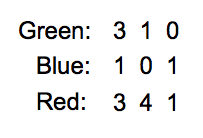In a prior blog post, I introduced my new puzzle, Arranging Addends, that mixes arithmetic with logical thinking to create an engaging playground for mathematical discovery. Let’s revisit this puzzle and introduce some new variations.
Take a look at the puzzle below (and here), built with Web Sketchpad. Your goal is to arrange the circles and as many of the five numbers that sit below them as needed to meet three conditions simultaneously: The sum of the numbers in the green circle is 12, the sum of the numbers in the blue circle is 27, and the sum of the numbers in the red circle is 29. The numbers can be dragged into the circles, and the circles can be moved as well. Dragging the point that sits on the circumference of each circle changes the circle’s size.
Students quickly discover that the puzzle isn’t as straightforward as it looks. The numbers 4 and 8 are needed to make a sum of 12, but they are also needed to make a sum of 29 (1 + 4 + 8 + 16). How can the 4 and 8 be in both circles at once? The key insight—one that students discover on their own— is to overlap circles so that a number can reside in more than one circle.
Students can play Arranging Addends multiple times, pressing the New Puzzle button to generate new, random challenges with different target sums between 1 and 31. As students develop facility with addition, they progress to the puzzles below (and here), which now include 32 as a possible addend.
Here is a variation of the puzzle with positive and negative addends (hat tip to Tom Francome for the suggestion).
Students can also create Arranging Addends puzzles of their own. In the puzzles below (and here), one student enters sums between 1 and 63 for each of the three target sums and then her partner solves the puzzle.
Below (and here) is a twist on Arranging Addends. Now, rather than using addends that are powers of 2, the addends are powers of 3, and there are two of each addend. Unlike the original collection of addends where there was just one solution to each puzzle, the powers of 3 often yield multiple solutions.
And below (and here) is yet one more version of the puzzle, this time with powers of 5.
After you’ve solved some puzzles using the powers of 5, press the arrow in the lower-right corner of the sketch to move to a second model. Notice that in addition to the circles and the addends, this model contains boxes for you to input your answers as a code. How does the code work? Well, as a hint, notice that the 25’s sit above one column of boxes, the 5’s sits above another column, and the 1’s above the remaining column of boxes.
Even if your students have never been exposed to working in different bases, they can still quickly understand how to use these boxes for record keeping. For example, if the green sum is 60, we can spare ourselves the trouble of saying that we need two 25’s, two 5’s, and zero 1’s and simply write “220” (which happens to be 60 in base 5).
These codes can help students devise a strategy for placing the addends into the circles. For example, suppose we’re given a puzzle where the green sum is 80, the blue sum is 26, and the red sum is 96. First, we write these numbers in code:
A student might then reason as follows to determine how to arrange the circles and addends:
“Let me do the 25’s first. The circles all need at least 1, so I put 1 in the overlap of all three, and then I need 2 more 25’s for the green/red overlap.”
“Now the 5’s. I don’t put any in the overlap of all three circles, but I put 1 in the overlap of the green/red. Now I just need three more 5’s in the red circle.”
“Finally the 1’s. I only need one of those, in the blue/red overlap. All done.”
Younger students might simply solve the puzzles without the code. Older students can use the codes to record their solutions, explain their solution strategies, and to find ways to make their strategies more efficient. Some students are likely to recognize the correspondence between the codes and the solutions and invent the strategy described above: reading the solution directly from the code.
Overall, this collection of Arranging Addends puzzles covers a lot of mathematical territory!
An annotated list of all our elementary-themed blog posts is here.

that was fun